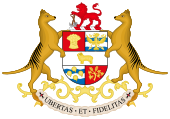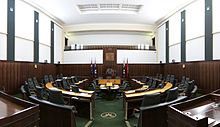
Back Assemblée de Tasmanie French 태즈메이니아주 의회 Korean Izba Zgromadzenia Tasmanii Polish Tasmanian House of Assembly SIMPLE
House of Assembly | |
|---|---|
| 51st Parliament | |
 | |
| Type | |
| Type | |
| History | |
| Founded | 2 December 1856 |
| Leadership | |
Chairman of Committees | |
Leader of the House | |
Government Whip | |
Leader of Opposition Business | |
Opposition Whip | |
Leader of Greens Business | |
Greens Whip | |
| Structure | |
| Seats | 35 |
 | |
Political groups | Government (14)
Confidence and supply (5)
Opposition (10)
Crossbench (6)
|
Length of term | 4 years |
| Elections | |
| Hare-Clark | |
Last election | 23 March 2024 |
| Meeting place | |
 | |
| House of Assembly Chamber, Parliament House, Hobart, Tasmania, Australia | |
| Website | |
| Tas House of Assembly | |
The House of Assembly, or Lower House, is one of the two chambers of the Parliament of Tasmania in Australia. The other is the Legislative Council or Upper House. It sits in Parliament House in the state capital, Hobart.
The Assembly has 35 members, elected for a term of up to four years,[c] with seven members being elected in each of five electorates, called divisions. Each division has approximately the same number of electors, and shares its name with one of Tasmania's federal electoral divisions. Voting for the House of Assembly is by a form of proportional representation using the single transferable vote (STV), known as the Hare-Clark electoral system. By having multiple members for each division, the voting intentions of the electors are more closely represented in the House of Assembly. This system makes it all but certain that the division's minority party wins at least one seat. Additionally, it is easier for minor parties to enter the legislature than in the rest of Australia, allowing them to possibly exert influence through the balance of power (the need for a working majority in the assembly).
At the 2024 state election, the size of the House increased from 25 to 35 members, with seven members elected from the five divisions.[2][3]
Since 2024, as well as previously from 1959–1998, the quota for election in each division, after distribution of preferences, has been 12.5% (one-eighth). Under the preferential proportional voting system in place, the lowest-polling candidates are eliminated, and their votes distributed as preferences to the remaining candidates. If a candidate achieves a quota, they are declared elected and any surplus votes (those over and above quota) are redistributed according to the next back-up preference marked by the voter.
Most legislation is initiated in the House of Assembly. The party or coalition with a majority of seats in the House of Assembly is invited by the Governor of Tasmania to form Government. The leader of that party becomes the Premier of Tasmania, and their senior colleagues become ministers responsible for various portfolios. As Australian politicians traditionally vote along party lines, most legislation introduced by the governing party will be passed by the House of Assembly.
Unlike other Australian state legislatures, the House of Assembly is elected from multimember districts while the Legislative Council is elected from single-member districts. The reverse is the case in most of the rest of Australia; that is, the lower house is elected from single-member districts while the upper house is elected from multi-member districts or at large.
Tasmania has therefore been described has having an upside down system to the rest of Australia.[4]
Cite error: There are <ref group=lower-alpha> tags or {{efn}} templates on this page, but the references will not show without a {{reflist|group=lower-alpha}} template or {{notelist}} template (see the help page).
- ^ Constitution Act 1972 (Tas) s.79
- ^ "Expansion of House of Assembly Act 2022". legislation.tas.gov.au.
- ^ Matt Maloney (17 November 2022). "Tasmania's House of Assembly to have 35 members in 2025 - if not sooner". The Examiner.
- ^ https://www.parliament.tas.gov.au/__data/assets/pdf_file/0031/58819/ha20select20on20ha20restoration20legislation202220july202019_.pdf
© MMXXIII Rich X Search. We shall prevail. All rights reserved. Rich X Search